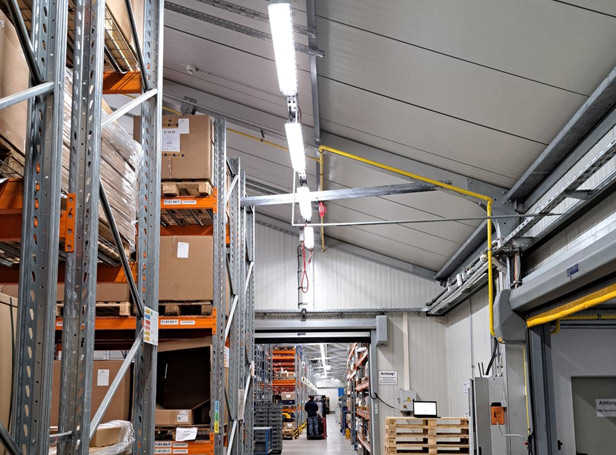In light of global environmental issues, reducing sulphur emissions is essential – and that includes the shipping industry. As a result, shipowners are now looking at rising costs. They must either bunker reduced-sulphur MDO, which is relatively expensive, or they must install sulphur scrubbers. One alternative to this is to use sulphur-free LNG as a "transition" fuel. The long-term goal is to fully decarbonise the maritime shipping industry.
Internationally applicable regulations that came into force on January 1st 2020 stipulate that the sulphur content of marine fuels used in transoceanic transportation must not exceed 0.5%, a limit that was previously set at 3.5%. The goal is to reduce sulphur oxide (SOx) emissions, creating a healthier environment around ports and in coastal regions. Certain areas with exceedingly delicate ecosystems are designated Sulphur Emission Control Areas (SECAs) – the emissions cap in these locations is even lower, at 0.1%. Protected zones like this already exist in the North Sea and the Baltic Sea, along the coastlines of the USA and Canada, around Iceland and in parts of China. The Mediterranean Sea will be subject to the stricter sulphur limits from 2025. According to the UN Environmental Program's calculations, the introduction of the cap in the Mediterranean Sea will result in a 78.7% reduction in overall sulphur oxide emissions in the region.
The International Maritime Organization's (IMO's) Marine Environment Protection Committee (MEPC) approved and adopted precise guidelines for implementing the sulphur cap that would come into force in 2020. These guidelines are set out in Annex VI of the MARPOL Convention (International Convention for the Prevention of Pollution from Ships). All signatories to this convention are jointly responsible for overseeing its implementation and enforcing it.
Residual fuel oil does not belong in the ocean
The unfiltered combustion of heavy fuel oil on the open sea has finally come to an end – a thoroughly deserved downfall for a highly polluting practice. Heavy fuel oil is actually just the residual fuel oil left over as a waste product of the refining process. It is not suitable for use in cars or heating systems. The amount of pollutants it contains is far too high, and it has been falling foul of the permitted levels in these areas for quite some time. In decades past, shipowners were able to obtain it at rock-bottom prices. The heavy fuel oil blend that was once the go-to choice is now often rejected in favour of cleaner fuels, in particular marine diesel oil (MDO) and liquefied natural gas (LNG). Both of these have a significantly lower sulphur content than heavy fuel oil.
Cleaning exhaust gas with scrubbers, etc. is only the third-best solution
As an alternative, the IMO permits the use of an exhaust gas cleaning system (EGCS) known as a scrubber to desulphurise the ship's exhaust gases. These systems may be used only on condition that the resulting SOx concentrations are no higher than if low-sulphur fuels had been used.
LNG, MDO, or conventional fuel in conjunction with desulphurisation systems – which is the more sustainable alternative? For existing ships, shipowners generally opt to retrofit desulphurisation systems. There are "dry" variants, which bind sulphur compounds in lime substrates. This produces gypsum. In contrast, gas washers – the true scrubbers – use a "wet" process, in which they wash the sulphur oxides out of the exhaust gas. These scrubbers can either be used with salt water or they can be used with fresh water to which sodium hydroxide solution has been added. The process produces sulphuric acid or sodium sulphate.
The use of scrubber systems has its own set of problems. The wash water is often discharged into the sea. Not only is it more acidic than the seawater, it also contains heavy metals, sulphates, nitrates and PAHs (polycyclic aromatic hydrocarbons), which are known to be carcinogenic. Closed-loop scrubber systems, which typically use alkaline water, convey the wash water into a process tank rather than releasing it directly into the sea. Particulate matter and PAHs are then removed in a water treatment unit. The purified wash water is not discharged into the sea until its pH has been adjusted and it has been cooled in a heat exchanger. Another alternative is to use a dry desulphurisation system, in which sulphur oxides and other air pollutants are bound with sodium bicarbonate (i.e. baking soda). In the hot exhaust gas stream, this decomposes into sodium carbonate, which reacts with sulphur oxides. The sodium sulphate, soot and heavy metal particles that this process produces are trapped using a filtration system. Even the 0.1% emissions limit that applies in SECAs should be attainable with this system.
Premium-quality marine diesel with less than 0.1% sulphur
All scrubber systems generate waste products which, if they are not dumped in the sea, must be taken to a waste disposal site. This can be expensive. It may be more logical to simply use low-sulphur fuels. Small ships fairly often opt for marine diesel oil, a blend of middle distillates from the crude-oil refining process. Depending on the grade, this may contain less than 1.0% or up to 1.5% sulphur. The sulphur content of low-sulphur marine gas oil (LS-MGO or VLSF, very low-sulphur fuel) is below 0.1%. For voyages that involve traversing or entering ECAs, for example, even large ships turn to low-sulphur marine diesel. However, the most commonly used fuels in the shipping industry are still what are known as intermediate fuel oils, blends of residual fuel oils and distillate fuels.
Sulphur-free LNG also reduces your carbon footprint
As you can see, even with MDO, it is difficult to comply with the strict limits stipulated in the most recent IMO regulations (MARPOL Annex VI). Further tightening of the emissions limits is on the cards. This is why shipowners have recently started to look to liquefied natural gas (LNG) as the future-ready fuel for powering their ships. In the future, bio or synthetic forms of LNG may be more common. Since LNG tankers are not at all new to using LNG as fuel, this technology is already fully developed and proven to work. LNG contains only negligible amounts of sulphur, as the vast majority of the sulphur compounds are removed when the natural gas is liquefied. So when LNG is burned, the sulphur oxide emissions are close to zero. The use of LNG also reduces the carbon footprint of the ship's propulsion system by around 20%. Emissions of nitrogen oxides and soot particles also fall by approximately 85%.
Invest in LNG engines and avoid waste disposal site costs
If they are to run on gas, ships will need to be converted. In addition to suitable engines, they will need further equipment such as insulated pressure vessels to store the cryogenic LNG. These occupy more space than heavy-fuel-oil tanks. A fuel gas supply system (FGSS) is also necessary in order to vaporise the cryogenic LNG and deliver the boil-off gas to the engine. Depending on the variant, the gas may be compressed beforehand by a high-pressure gas compressor. All this requires a considerable investment. However, this is offset by the fact that LNG does not require an exhaust gas cleaning operation in order to comply with the strict limits, and there is no wash water to dump or filtration materials to dispose of at a waste disposal site.
Seven new cruise liners, quite a few ferries, four container ships and two car carriers are now powered by LNG. Additionally, multiple suppliers are now marketing dual-fuel propulsion systems, which can run on either LNG or MDO. These can sometimes be used without further investment in an exhaust gas after-treatment system. However, high LNG prices have led some operators to use their dual-fuel propulsion systems predominantly with MDO, which is bad news for the environment. Yet another variant is the combination of LNG with a solid oxide fuel cell (SOFC), which is said to reduce greenhouse gas emissions by a further 30% compared with LNG alone.
Commitment to preventing the escape of methane
Despite its low sulphur and nitrogen content, in terms of greenhouse gas emissions, LNG only outperforms MDO under one crucial condition: Right from when the LNG is first produced, through to its liquefaction, transportation and combustion, it is important to ensure that as little methane escapes as possible. Methane massively amplifies the greenhouse effect. Four-stroke engines are particularly susceptible to methane escaping because the intake valve and exhaust valve are briefly open at the same time. Two-stroke engines don't have this problem, and should be able to successfully contain the methane.
Many of these engines are currently on order, indicating that we will soon be seeing many more new ships that either run on LNG alone or use the dual-fuel propulsion system. They will be able to comply with the even stricter emissions requirements that the IMO has in store for us. Shipowners who have opted for an LNG propulsion system will benefit from medium- to long-term investment security.
LNG propulsion systems equip ships for even stricter limits
While LNG has already garnered people's interest, methanol is also being discussed as an alternative fuel source. Like LNG, it contains no sulphur compounds, so it emits no sulphur oxides when burned. And like LNG, it is a potential transition fuel for the shipping industry.
In the distant future, when we hope that the shipping industry will be able to operate entirely without fossil fuels or CO2 emissions, we will probably see increased use of fuel cells with energy derived from green hydrogen for powering ships. The use of hydrogen is still in its infancy, with only a few inland waterway vessels currently powered by it. Until this technology becomes widespread in the maritime shipping industry, we will have to work on producing green hydrogen in large quantities and, more importantly, making its production cost effective. Technical issues such as metal's tendency to become very brittle on contact with hydrogen need to be resolved. And ports will need to be upgraded to accommodate the hydrogen supply system. All this is likely to take decades. Since ships can typically be operated for up to 30 years or sometimes more, opting for LNG propulsion technology now should be the perfect stopgap until hydrogen becomes a realistic option.
Further Reading:
These articles might also interest you

What Asset Administration Shells Deliver for Maintenance






![[Translate to Englisch:] [Translate to Englisch:]](/fileadmin/user_upload/mitarbeiter/01_DE/07_Blog/00_Allgemein/blog-explosionsschutz-rstahl-startseite-279x205.jpg)
![[Translate to Englisch:] [Translate to Englisch:]](/fileadmin/user_upload/mitarbeiter/01_DE/07_Blog/00_Allgemein/blog-explosionsschutz-rstahl-ueber-den-blog-279x205.jpg)
![[Translate to Englisch:] [Translate to Englisch:]](/fileadmin/user_upload/mitarbeiter/01_DE/07_Blog/00_Allgemein/blog-explosionsschutz-rstahl-autoren-279x205.jpg)
![[Translate to Englisch:] [Translate to Englisch:]](/fileadmin/user_upload/mitarbeiter/01_DE/07_Blog/00_Allgemein/blog-explosionsschutz-rstahl-newsletter-expert-mail-279x205.jpg)
Write new comment